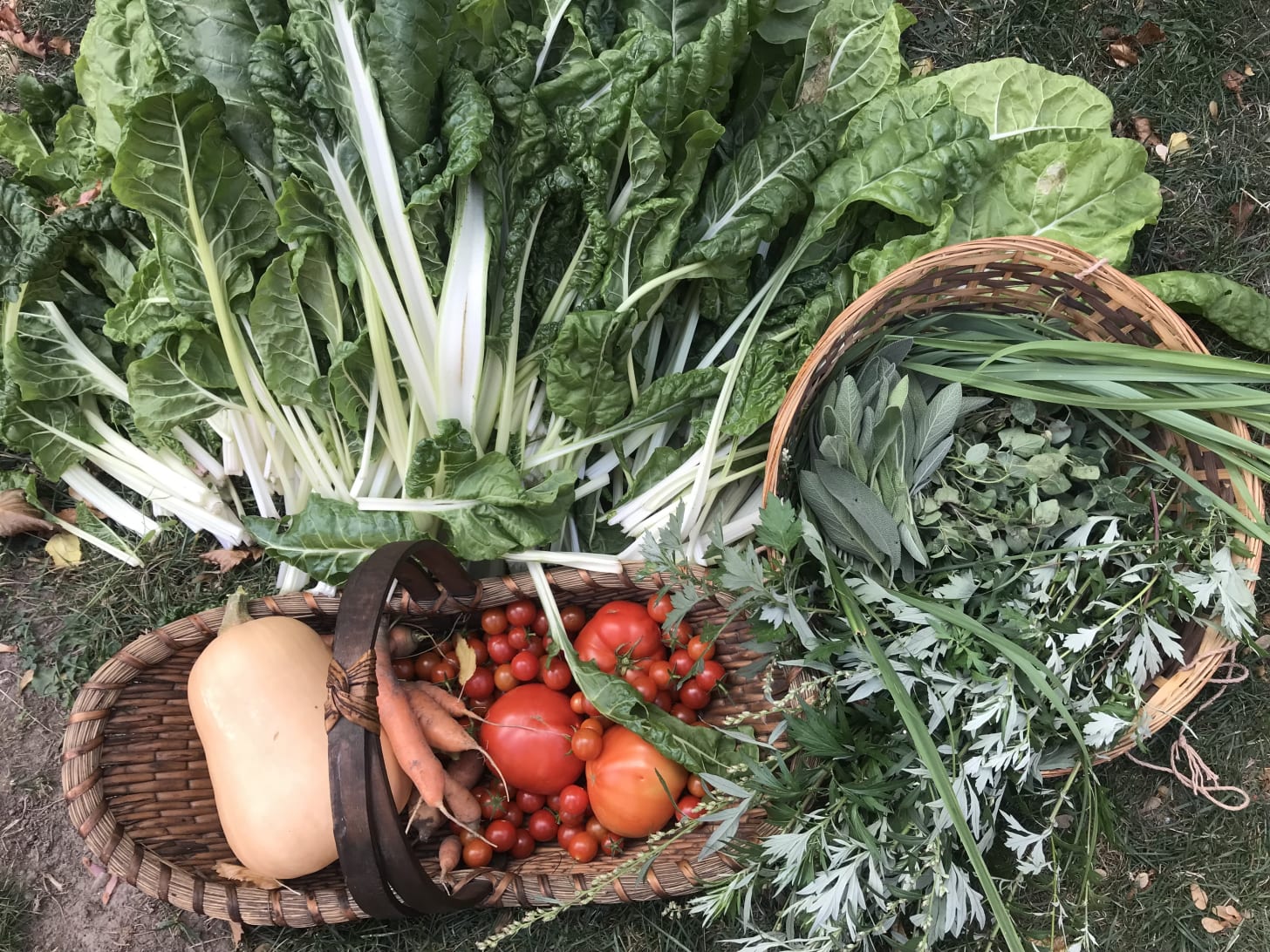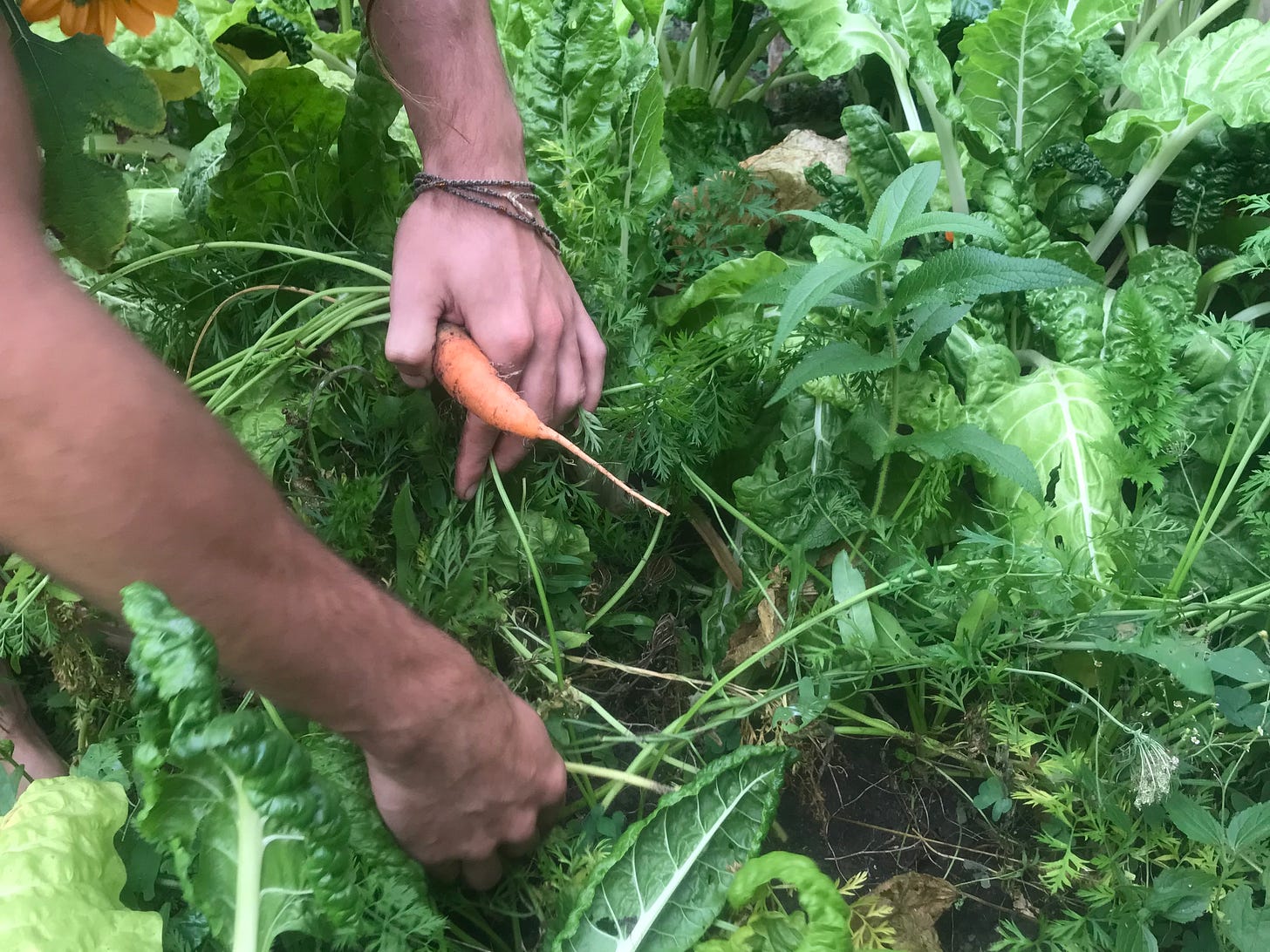Gardening the wild land
on gardening as an ecologically healing practice and reframing the ideas of traditional gardening into thriving wild ecosystems
Gardening is a deeply connective process. One that ties us to the WEB of nourishment, sustenance, wild ecology and intention. It is a really special way humans have woven themselves into the natural world, working with the powers of growth and the life cycles of plants to provide rich food for us. Gardens have been around for millennia, humans have a natural urge to make beautiful things and tend to the land. This is not new. But every intention woven into the space is unique.
These days it has become twisted into the same routine that we see everywhere in a monochrome culture. Order, control, columns and rows, sameness. Mainstream gardening has grown more and more challenging with more and more work needing to be put into maintaining an unnatural environment. Essentially, one that is stuck in a perpetually immature state, not allowed to grow beyond the initial annuals and pioneering plants. Attempting to keep a garden in this state, where only your annual vegetables are growing in orderly rows tightly controlled with weeding regimes and fertilizers adds a lot of work to the gardener trying to go against the natural succession of a healthy ecosystem. Beyond the gardener, it is a depleting practice for the land and doesn't offer much opportunity for life to truly take root in the ways it desires.
In the environment, there is a process called succession. When a piece of land has been cleared or plowed, we can see this process very clearly. The first plants on the scene are often those that we define as weeds, those prolific growers often found on disturbed ground. They thrive in this environment with exposed ground, lots of sun and soil that other plants would not be able to survive in, soil that has become heavily compacted or depleted. These are the pioneer plants, they are the beginning of reestablishing a healthy ecosystem. Once the pioneer plants aerate the soil, bring up nutrients from deep in the ground with their long taproots, and create more moisture through their ground cover, other plants are able to be seeded in their nursery-like environment. These plants hold ever more complex niches that begin to fill the space, plants like shrubs and wildflowers. the environment grows gradually into more complexity, more perennials, and eventually, trees are able to take root. When an environment has enough moisture, it will naturally succeed towards a sort of forest ecosystem. Plants begin to mature as they get older and become the guides and protectors for the younger, more delicate plants. Essentially the ecosystem is maturing, growing, becoming more complex and diverse. This is the natural tendency of the land. What is happening in gardens is that people are trying to keep their ecosystem in that first stage of succession. Mostly annual, very young plants that aren’t allowed to mature, when weeds come in to nurture and enhance the ecosystem they are quickly eradicated and the garden is kept in a sort of unsatisfactory loop. It requires a lot of work to maintain such an unnatural state. Here comes the plows, the fertilizers, the pesticides, the bare soil and rows of sameness. This sort of gardening, although may appear to provide high yields and an abundance of food, it is lacking true life. True nourishment. True habitat for other creatures we share the land with. The innate diversity and complexity of a thriving ecosystem. And the true ease that can be our relationship with the land and our communion with the things that we grow.
This sort of gardening creates a desert where other species cannot thrive and are forced to find their food and habitat somewhere else. With already a ridiculous amount of bare lawns and gardens lining rows and rows of houses and condos, they quickly run out of options - especially in an urban environment.
Many of the practices that we hear now like permaculture and ecological gardening, are moving with the intention to do as we see the land do. Watch and learn and mimic. Planting more perennial plants that will be allowed to mature into foundational plants within their ecosystem. Planting flowers for the essential health of bugs and pollinators. Providing cover crops that protect the soil - when do you ever see exposed soil in an undisturbed healthy wild place? Creating habits for the other inhabitants of the space. This way is reflecting the complexity that we want to bring into the space, and allowing it all to take root in a natural unfolding, into intentional wild food gardens and forests. The more we allow the environment to be naturally what it desires, the less energy we need to put in to keep it under control, it will naturally find its harmony. It becomes a closed loop that is able to sustain itself. All nourishment is recycled back into the land rather than leached out like in traditional gardening.
It creates a deeply nourishing reciprocal relationship that isn’t back-breaking work but easeful presence and occasional maintenance. This is the sort of gardening that takes US out of the central focus. The only purpose mainstream gardening serves is solely to provide food for humans by any means necessary. Instead, through an ecological gardening framework we are invited to expand our purpose for showing up in a garden space. Expanding our service beyond growing food for ourselves to providing sustenance for our kin. Creating a healthy habitat for our relatives. Creating a space that is alive and bursting with life rather than a land equivalent to being on IV drops.
Over the last few months I have been exploring the realm of natural gardening that creates healthy living ecosystems we all may be nourished by, and I'm excited to share with you all the different elements that go into it. It perhaps sounds daunting, hard and misunderstood. My hope is to make this knowledge accessible and understood in a way that makes it easy to implement. It is not hard, just different than so much of what we have been taught about gardening. It is a sort of unravelling of old information and reweaving another way. This folks, is how we reclaim our individual responsibility for our actions and the way we are in relationship with the land. How we tend to healthy ecosystems instead of desolate landscapes. Devote of life. Deserts in what could be thriving ecosystems.
It is a journey of wild gardening. Of taking care of our relatives. Being truly responsible in our role as gardeners. As we weave ourselves as a part of a wild land, we grow deeper into our wild selves. This nourishment radiates out and out through our hands, our hearts, to touch all things. The land rejoices. The spirits sing. Our animal kin are led back to their rightful homes and celebrated. Life is full.
P.S. My book ‘The Mythic Womb’ is officially published on amazon. I talked a bit about this soul gift in my last post. It is with big pleasure and joy that I share it with you all now. Find it in the link below. As always, thank you truly madly deeply for all the support and presence you offer to this space.








Wild gardening! For the past ten years I have worked for and with Wild Garden Seed - which has long had a philosophy of growing with diversity, allowing winter weeds to be cover crops, not always in straight rows.
For me, I would say that I feel like there is a spectrum of ways to approach growing food. On one end is the industrial chemical monoculture that is so dominant. On the other end is wildcrafting, permaculture, no tillage, working to build self-sustaining ecosystems that also give us food. But it's difficult to grow cabbage that way, or lettuce, or potatoes, or corn or beans or squash, or most of the annual food crops that our ancestors have created in collaboration with wild plants.
In between, there is a way of gardening that feels in a sense like creating an extension of self - a boundary within which I work more intensively with the land so that it is not wild per se, but it is still effectively in harmony rather than in a state of battle. I explored this somewhat in my most recent regular post: https://dendroica.substack.com/p/the-pandora-possibility
In terms of fertility in food-growing lands, the biggest challenge we face in our modern society, it would seem, is getting the nutrients from our own excretions back to the plants. It is both taboo and physically challenging when they are flushed down pipes and mixed with all manner of toxins from which they are not easily separated. It's tough to get away from the need to add fertility until we can close our nutrient loops.
Wild gardening! I do love that term. To caretake the land as you speak encourages so much more... thank you for sharing your wisdom here. I live in an apartment and we have more pots on the balcony than there is space to move, yet the birds, the bees, the butterflies, the possums and I'm sure the mice all come and nibble. I wonder, in your lush garden what do you do when the wildlife nibble more than you can harvest yourself? Or when the teeny tiny shoots are there one day and gone the next?
Thank you for this lovely post... I feel expanded in reading it. 🪴🍁🌱